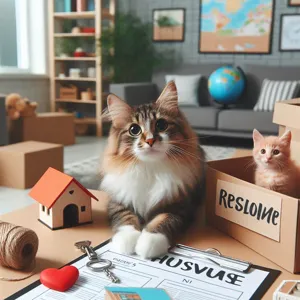For many pet lovers, the joy of having a furry companion often comes hand-in-hand with unexpected challenges, one of the most common being pet allergies.
Sneezing, itching, and watery eyes can turn the delight of cuddling with your beloved animal into a struggle for comfort. But fear not—creating a happier home for both you and your pet is entirely possible with the right strategies in place. In this blog post, we’ll explore effective tips and tricks to help you minimize allergens and keep your living space serene. From smart grooming techniques to air quality improvements and thoughtful home organization, you’ll discover practical ways to enjoy the companionship of your pets without compromising your health. Whether you’re a seasoned pet owner or welcoming a new addition to your family, these strategies will ensure that your home remains a sanctuary for everyone.
1. Understanding Pet Allergies: Causes and Symptoms

understanding pet allergies is the first essential step toward creating a happier, healthier home for both you and your furry companions. Pet allergies are typically triggered by proteins found in a pet’s skin cells, urine, saliva, and even their dander—the tiny flakes of skin that can easily become airborne. For many individuals, these allergens can provoke a range of uncomfortable symptoms, making it crucial to identify and manage them effectively.
common symptoms of pet allergies include sneezing, runny or stuffy noses, itchy or watery eyes, and skin irritations such as rashes or hives. In more severe cases, allergies can exacerbate asthma or lead to other respiratory issues, causing distress for both the affected individuals and their pets. It’s important to note that these symptoms can sometimes mimic those of seasonal allergies, making it even more vital to consult with a healthcare professional for accurate diagnosis and management.
While it may seem daunting to navigate life with pet allergies, understanding the root causes can empower you to take proactive measures. For instance, certain breeds are known to produce fewer allergens, making them more suitable for allergy sufferers. Additionally, recognizing the specific allergens that trigger your symptoms can help you formulate a tailored strategy to minimize exposure, ensuring your home remains a safe haven for all its inhabitants. By staying informed about pet allergies and their symptoms, you can take the first steps toward creating a balanced environment that accommodates both your beloved pets and your health needs.
2. Identifying Allergens: Common Triggers in Pets
Identifying allergens is a crucial step in managing and preventing pet allergies, as understanding what triggers your pet’s reactions can lead to a happier home for both you and your furry friend. Allergens can come from a variety of sources, and recognizing these common triggers is essential to mitigating their effects.
One of the most prevalent allergens found in pets is pollen. As the seasons change, so too does the pollen count in the air, with grasses, trees, and weeds all contributing to potential allergic reactions. It’s not just the outdoors that can trigger allergies, though; indoor allergens, such as dust mites, mold, and pet dander, can build up in your home, exacerbating your pet’s discomfort. Regular cleaning, including vacuuming carpets and washing bedding, can help reduce these irritants.
Food allergies are another significant concern. Dogs and cats can develop sensitivities to certain ingredients, often seen in common proteins like beef, chicken, or dairy. If your pet is exhibiting symptoms such as itching, gastrointestinal upset, or ear infections, it may be time to evaluate their diet. Consulting with your veterinarian to conduct an elimination diet can help pinpoint the offending ingredient.
Flea allergies are particularly common, with even a single flea bite capable of triggering intense itching and irritation. Maintaining a regular flea prevention regimen is essential, especially in warmer months when these pests are more prevalent.
Lastly, consider environmental changes. New cleaning products, scented candles, or air fresheners can introduce additional allergens into your home. Opt for hypoallergenic or unscented products whenever possible to create a safer space for your pet.
By identifying and addressing these common allergens, you can significantly reduce the risk of allergic reactions, promoting a healthier and happier living environment for both you and your beloved pet.
3. Choosing the Right Pet: Allergy-Friendly Breeds

When it comes to selecting a pet for your household, one of the most crucial considerations is the impact they may have on allergies. Not all furry friends are created equal, and some breeds are gentler on the sinuses than others. If you’re prone to allergies but still wish to welcome a pet into your life, opting for allergy-friendly breeds can significantly enhance your living experience.
Hypoallergenic pets, such as Poodles, Bichon Frises, and Portuguese Water Dogs, are known for producing fewer allergens compared to traditional breeds. These dogs have hair rather than fur, which means they shed less and trap dander more effectively, resulting in a cleaner environment. Similarly, certain cat breeds, like the Siberian or the Balinese, are also known to produce lower levels of the Fel d 1 protein, a common allergen found in cat saliva and skin.
It’s essential, however, to keep in mind that no pet is entirely hypoallergenic. Individual reactions can vary, and some people may still experience symptoms even with allergy-friendly breeds. Before making a commitment, consider spending time with the breed you’re interested in to gauge your body’s reaction.
Additionally, incorporating thorough grooming routines and regular cleaning protocols can help minimize allergens. Consider brushing your pet outdoors to reduce the amount of dander and hair that finds its way into your home, and invest in quality air purifiers to keep the air fresh and clean. By carefully selecting the right breed and taking proactive measures, you can create a harmonious living space that accommodates both your health needs and your desire for a pet companion.
4. Regular Grooming: Reducing Dander and Allergens
Regular grooming is a cornerstone strategy for managing pet allergies and promoting a healthier home environment. When pets shed fur or dander, these tiny particles can quickly accumulate in your living space, triggering allergic reactions for sensitive individuals. By incorporating a consistent grooming routine, you can significantly reduce the amount of allergens that circulate in your home.
Start by brushing your pet at least once a week, or more frequently for long-haired breeds. This not only helps to remove loose fur and dander but also prevents matting, which can trap even more allergens. Consider investing in a high-quality grooming tool, such as an undercoat rake or a deshedding brush, designed to effectively capture those pesky particles before they have a chance to become airborne.
Bathing your pet regularly is another effective way to keep allergens at bay. Aim for a bath every four to six weeks, using a gentle pet shampoo that can help to remove dander and dirt. Be cautious not to over-bathe, as this can strip your pet’s skin of its natural oils and lead to dryness or irritation.
If your furry friend isn’t fond of water, consider professional grooming services. A groomer can provide a thorough cleaning and potentially use techniques that may be difficult to replicate at home. Additionally, they can offer helpful tips and tricks for managing your pet’s coat based on their specific breed.
Incorporating regular grooming into your pet care routine can lead to a noticeable decrease in allergens in your home, making it a vital strategy for allergy sufferers. Not only does grooming benefit your pet’s health and appearance, but it also fosters a cleaner, more comfortable living environment for everyone. With these steps, you can help ensure that both you and your beloved pet enjoy a happier, healthier home.
5. Maintaining a Clean Home: Effective Cleaning Tips

Maintaining a clean home is crucial for managing pet allergies and creating a more comfortable environment for both you and your furry friends. Allergens can accumulate quickly, so adopting a proactive cleaning routine can significantly reduce the presence of pet dander, fur, and other irritants.
Start by establishing a regular cleaning schedule that includes weekly vacuuming and dusting. Invest in a high-efficiency particulate air (HEPA) filter vacuum cleaner, as it effectively traps allergens and prevents them from being released back into the air. Don’t forget to vacuum upholstered furniture and curtains, where pet hair tends to cling. In addition to vacuuming, consider using a microfiber cloth or electrostatic dusters to minimize dust accumulation on surfaces throughout your home.
Wash your pet’s bedding, toys, and blankets regularly—at least once a week—with hot water to eliminate dander and bacteria. Designate certain areas of your home as pet-free zones, particularly bedrooms, to create a safe haven where allergens are minimized.
Regular grooming is another essential component of a clean home. Brush your pets often, preferably outdoors, to remove loose fur and dander before it can scatter throughout your living space. This not only helps keep your home cleaner but also contributes to your pet’s overall health and comfort.
Consider using an air purifier with a HEPA filter in high-traffic areas or rooms where your pets spend the most time. These devices can help remove airborne allergens and improve the air quality in your home. Finally, don’t overlook the importance of cleaning your floors and surfaces with pet-friendly cleaning products to avoid introducing additional irritants.
By implementing these effective cleaning tips, you can create a cleaner, healthier environment that minimizes pet allergies and helps everyone in your household breathe easier. With a little effort and consistency, you can enjoy the companionship of your pets without the discomfort of allergies.
6. Air Quality Matters: Using HEPA Filters and Air Purifiers
When it comes to creating a comfortable home for both you and your furry friends, air quality is paramount. Poor air quality can exacerbate pet allergies, causing discomfort and health issues for both pets and humans alike. One of the simplest yet most effective strategies to combat allergens in your home is to invest in HEPA filters and air purifiers.
HEPA, which stands for High-Efficiency Particulate Air, is a type of filter that can trap 99.97% of particles as small as 0.3 microns. This includes pet dander, dust mites, pollen, and even some bacteria. By integrating HEPA filters into your home’s HVAC system, or by using portable air purifiers equipped with HEPA filters in high-traffic areas, you can significantly reduce the amount of airborne allergens.
Place air purifiers in the rooms where your pets spend the most time—like the living room or bedroom—to create cleaner air zones. Not only will this help in filtering out pet-related allergens, but it will also enhance the overall air quality, making the environment more breathable for all occupants.
In addition to using HEPA filters and air purifiers, it’s wise to regularly change your home’s HVAC filters. Opt for filters that are rated MERV 11 or higher for maximum allergen capture. Regular maintenance ensures that your systems are functioning optimally and helps keep the air circulating in your home fresh and clean.
By prioritizing air quality with HEPA filters and air purifiers, you’ll create a healthier living space that minimizes allergens, supports your pets’ well-being, and promotes a happier home for everyone.
7. Creating Allergen-Free Zones: Your Pet-Free Spaces

Creating allergen-free zones within your home can be a game-changer for allergy sufferers while still allowing you to enjoy your beloved pets. These designated spaces act as sanctuaries where you can retreat from pet dander, fur, and other allergens, promoting a healthier and more comfortable living environment.
Start by identifying areas in your home that will remain pet-free, such as bedrooms or home offices. These zones should be strictly off-limits to your furry friends. Use doors or baby gates to establish boundaries, ensuring that your pets understand where they can and cannot go. Consider using air purifiers with HEPA filters in these spaces to further reduce allergens and improve air quality.
Additionally, choose hypoallergenic bedding and furnishings for your allergen-free areas. Opt for materials that are less likely to trap dander and dust, such as leather or tightly woven fabrics. Regular cleaning is crucial; wash linens and vacuum carpets often to minimize allergen buildup.
By establishing these pet-free zones, you create a balance in your home that allows you to enjoy the companionship of your pets without sacrificing your comfort or health. These dedicated spaces can provide relief from allergies, enabling you to recharge in a tranquil environment, ultimately leading to a happier home for both you and your furry friends.
8. Bathing Your Pet: How Often and Why It Helps
Bathing your pet might seem like a chore, but it plays a crucial role in managing pet allergies and ensuring a happier, healthier home. Regular baths help remove allergens that accumulate on your pet’s fur, skin, and paws, such as dander, dust, pollen, and even bacteria. The frequency of bathing can vary based on your pet’s breed, coat type, and lifestyle, but a general guideline is to bathe your dog every four to six weeks. Cats, on the other hand, often require less frequent baths since they are proficient self-groomers, though occasional baths can still be beneficial, especially for long-haired breeds.
When you bathe your pet, opt for a hypoallergenic or gentle pet shampoo that won’t irritate their skin. This can help reduce the release of allergens while also promoting a shiny, healthy coat. Be sure to rinse thoroughly to remove all soap residue, as leftover products can lead to skin irritation.
In addition to reducing allergens, regular baths can help you keep an eye on your pet’s skin condition. You’ll be more likely to notice any unusual bumps, redness, or irritations that may need veterinary attention, ensuring that your furry friend stays happy and comfortable.
Lastly, a clean pet is also a happy pet! Most animals enjoy the refreshing feeling of a good bath, and the bonding time spent together during this process can strengthen your relationship. By incorporating regular bathing into your pet care routine, you’ll not only help alleviate allergies in your home but also create a more pleasant environment for both you and your furry companion.
9. Managing Outdoor Allergens: Strategies for Pet Owners
Managing outdoor allergens is crucial for pet owners who want to maintain a happy and healthy environment for both their furry friends and themselves. While we often think of indoor allergens like dust mites and mold, outdoor elements such as pollen, grass, and weeds can trigger allergies just as easily. By implementing a few proactive strategies, you can minimize your pet’s exposure to these irritants, ensuring a more comfortable living space.
First and foremost, consider scheduling regular outdoor activities during times when pollen counts are lower. Early mornings or late afternoons are typically ideal, as mid-day tends to feature peak pollen levels. Additionally, keeping your yard well-maintained can help reduce allergen accumulation. Regularly mowing your lawn, trimming hedges, and removing weeds not only enhances your outdoor space but also cuts down on the potential for allergens to thrive.
When your pet comes indoors after spending time outside, establish a routine to help minimize allergen transfer. A quick rinse in the shower or a good wipe-down with a damp cloth can effectively remove pollen and other irritants from their fur. This simple practice not only keeps your home cleaner but also provides immediate relief for allergy sufferers.
It’s also beneficial to create a designated pet area in your home, preferably with easy-to-clean surfaces and materials that do not trap allergens. Using washable pet bedding and blankets allows for regular cleaning, further reducing the buildup of outdoor allergens. Additionally, consider using air purifiers equipped with HEPA filters, which can capture airborne particles, including pollen, keeping your indoor air fresh and clean.
Lastly, consult your veterinarian about potential allergy treatments for your pets. Allergy medications, including antihistamines or even immunotherapy, may be an option to help alleviate symptoms, allowing your beloved companion to enjoy the great outdoors without discomfort.
By being proactive about managing outdoor allergens, you can create a safer, more comfortable haven for your pet and your family. With a few thoughtful adjustments, you’ll ensure that your home remains a cozy retreat from the allergy-inducing elements lurking outside.
10. Nutrition and Supplements: Supporting Your Pet’s Health
When it comes to preventing pet allergies and ensuring a healthier home environment, nutrition plays a pivotal role. Just like humans, pets require a balanced diet rich in essential nutrients to bolster their immune systems and maintain optimal health. Quality pet food should be the foundation of your pet’s diet, focusing on high-quality proteins, wholesome grains, and plenty of fruits and vegetables. Ingredients like omega-3 fatty acids, found in fish oil, can significantly reduce inflammation and support skin health, which is crucial for pets that are prone to allergies.
In addition to a well-rounded diet, consider incorporating specific supplements that can further enhance your pet’s well-being. Probiotics, for instance, can improve gut health, which is directly linked to immune function. A healthy gut flora can help your pet resist allergens and reduce their severity when exposure does occur. Similarly, supplements like glucosamine and chondroitin can support joint health, which is especially important for older pets or those with allergies that might be compounded by mobility issues.
Before introducing any new foods or supplements, it’s always best to consult with your veterinarian. They can provide tailored recommendations based on your pet’s individual needs, taking into account factors such as age, breed, and existing health conditions. By prioritizing nutrition and proper supplementation, you’re not only supporting your pet’s overall health but also creating a solid foundation for allergy prevention, leading to a happier, more comfortable life for both you and your furry friend.
11. Regular Vet Visits: Importance of Health Checks
When it comes to preventing pet allergies and ensuring a happier home, regular vet visits are non-negotiable. Just like humans, pets require routine check-ups to monitor their health and address potential issues before they escalate. A visit to the veterinarian can help identify allergies early on, allowing you to take proactive measures to mitigate their effects.
During these health checks, veterinarians can perform allergy tests to determine specific sensitivities your pet may have, whether to environmental allergens like pollen and dust mites, or food-related triggers. This information is invaluable, as it enables you to tailor your home environment and your pet’s diet accordingly. For instance, if your furry friend is found to be allergic to a particular ingredient in their food, your vet can recommend suitable alternatives that will keep them happy and healthy without triggering allergic reactions.
Furthermore, regular vet visits offer an opportunity for vaccinations and preventive treatments, such as flea and tick control, which can significantly reduce allergy-related complications. Parasites can exacerbate your pet’s allergic reactions, so staying on top of preventive care is essential.
Additionally, these visits allow for open communication with your vet about any changes in your pet’s behavior or health. If you notice scratching, excessive licking, or unusual symptoms, bringing these up during your appointment can lead to early intervention and treatment, helping to keep your pet comfortable.
In summary, prioritizing regular veterinary visits is a cornerstone strategy in preventing pet allergies. Not only do these check-ups ensure your pet’s overall health, but they also empower you with the knowledge and tools to create a more harmonious living space for both you and your beloved companion. After all, a healthy pet is a happy pet, and that leads to a happier home for everyone involved.
12. Allergy Testing: Understanding Your Options
When it comes to managing pet allergies, understanding your options for allergy testing is crucial in creating a healthier home environment. Allergy testing can help identify specific triggers that may be causing discomfort, allowing you to take targeted action to mitigate symptoms.
There are generally two main types of allergy tests available: skin tests and blood tests. Skin tests are typically performed by an allergist, who will apply small amounts of various allergens to your skin through pricks or injections. By monitoring your skin’s reaction, the allergist can determine which substances you’re allergic to. This method is often quick and provides results within a short time frame, making it a popular choice for many pet owners.
On the other hand, blood tests can be useful, particularly for those who may have skin sensitivities or for children who can’t tolerate skin testing. These tests measure the level of specific antibodies in your bloodstream in response to allergens. While they may take longer to yield results compared to skin tests, they can offer a comprehensive view of your sensitivities.
Additionally, some pet owners might consider at-home testing kits that claim to identify allergies based on hair or saliva samples. While these can be convenient, it’s essential to approach them with caution. Their accuracy and reliability can vary significantly, and they should not replace professional advice.
Once you’ve identified your allergens through testing, you’ll be better equipped to implement strategies that can reduce exposure to these triggers. Whether it means investing in high-efficiency particulate air (HEPA) filters, regularly grooming your pet, or even considering hypoallergenic breeds, understanding your options through allergy testing is the first step toward a more comfortable coexistence with your furry friends. By empowering yourself with knowledge, you can make informed decisions that lead to a happier, healthier home for both you and your pets.
13. Using Medications Wisely: Antihistamines and More
When it comes to managing pet allergies, understanding how to use medications wisely can significantly enhance the quality of life for both you and your furry companions. Antihistamines, for example, are a popular choice among allergy sufferers. These over-the-counter medications work by blocking histamines—substances in the body that trigger allergic reactions. They can help alleviate symptoms like sneezing, itching, and watery eyes, providing much-needed relief.
However, it’s essential to consult with your veterinarian before starting any medication regimen for yourself or your pets. Some antihistamines are safe for pets, while others can cause adverse effects. Your vet can recommend the appropriate dosage and brand, ensuring that your pets remain happy and healthy while you manage your symptoms.
Beyond antihistamines, there are other medications you might consider, such as corticosteroids or leukotriene inhibitors, which can help reduce inflammation and provide additional allergy relief. These medications typically require a prescription and should be used with caution, as they can have side effects if used long-term.
In addition to pharmacological options, integrating preventive measures into your routine is crucial. Regular grooming and bathing of your pets can significantly reduce the amount of dander and allergens in your home. It’s also beneficial to use air purifiers with HEPA filters to trap airborne allergens, creating a cleaner environment.
By using medications wisely and combining them with proactive strategies, you can create a harmonious living space that minimizes allergy triggers and maximizes comfort for everyone in the household—humans and pets alike. Remember, a happy home is one where everyone can breathe a little easier!
14. Educating Your Family: Involving Everyone in Allergy Management
When it comes to managing pet allergies, education is an essential tool for fostering a healthier and more harmonious home environment. Involving your entire family in allergy management not only empowers them but also cultivates a collective sense of responsibility towards the well-being of both your pets and family members.
Start by holding a family meeting to discuss what pet allergies are, their symptoms, and how they can affect daily life. Use this opportunity to share valuable information about common allergens, such as pet dander, saliva, and urine, so that everyone understands the source of discomfort. Encourage questions and open dialogue to address any misconceptions and to ensure that everyone feels comfortable discussing their experiences and concerns.
Next, assign age-appropriate tasks to family members to help manage allergens. For younger children, simple activities like brushing the pet outside or being responsible for feeding can create a sense of involvement. Older children can take on more significant roles such as regular vacuuming, dusting, and even helping with the pet’s grooming routine. This not only helps in maintaining a clean environment but also instills a sense of teamwork and accountability among family members.
Moreover, consider creating a pet-free zone, such as bedrooms or play areas, where family members can retreat to minimize exposure to allergens. Educate everyone on the importance of keeping these spaces clean and free of pet hair. Establishing rules, such as removing shoes before entering the house or using an air purifier, can also be effective in reducing allergens.
Lastly, encourage empathy and understanding towards family members who may be more affected by allergies. Discussing ways to support one another, whether through helping with medication routines or simply being mindful of allergens, can strengthen family bonds and enhance the overall atmosphere of your home. By fostering a culture of awareness and cooperation, you can create a happier home for both your family and your beloved pets.
15. When to Seek Professional Help: Consulting Allergists and Veterinarians
When it comes to managing pet allergies, knowing when to seek professional help can make a significant difference in your and your furry friend’s quality of life. If you or a family member are experiencing persistent allergy symptoms—such as sneezing, itchy eyes, or skin rashes—that seem to correlate with your pet’s presence, it may be time to consult an allergist. Allergists specialize in diagnosing and treating allergic reactions and can conduct tests to determine specific allergens, helping you understand whether your pet is indeed the source of your discomfort.
On the other hand, if your pet is showing signs of allergies—like excessive scratching, biting at their skin, or chronic ear infections—it’s crucial to consult a veterinarian. They can provide insight into your pet’s condition and recommend appropriate treatments, whether that be medications, dietary changes, or specialized grooming routines. In some cases, the vet might even suggest allergy testing for your pet to pinpoint the allergens affecting them.
It’s essential to approach these consultations with detailed notes on symptoms, their frequency, and any observed patterns. This information can help both the allergist and veterinarian formulate a targeted and effective plan of action. Remember, addressing allergies early on can not only improve your pet’s comfort and health but can also create a more harmonious home environment for everyone involved. Don’t hesitate to seek professional guidance—your health and your pet’s well-being are worth it.
In conclusion, creating a happier home for both you and your furry friends is entirely achievable with the right strategies for preventing pet allergies. By implementing the tips outlined in this article—such as regular grooming, maintaining a clean environment, and choosing hypoallergenic products—you can significantly reduce allergens and enjoy the companionship of your pets without the discomfort of allergies. Remember, a little proactive care goes a long way in fostering a harmonious living space. Embrace these strategies, and not only will your home feel more comfortable, but your bond with your pets will also strengthen, allowing you to focus on the joy they bring to your life. Here’s to a healthier, happier home filled with love and wagging tails!
















